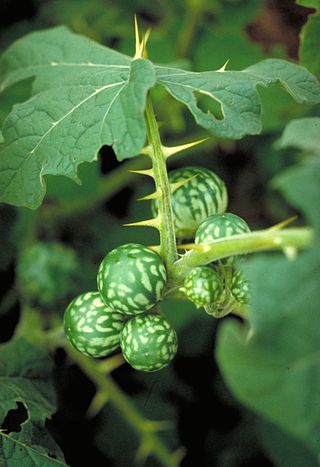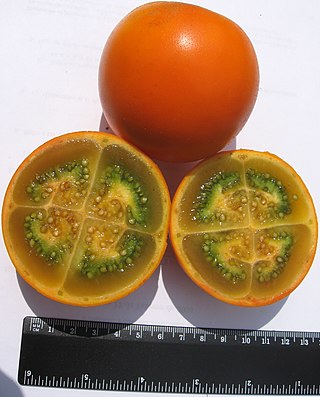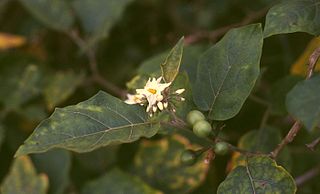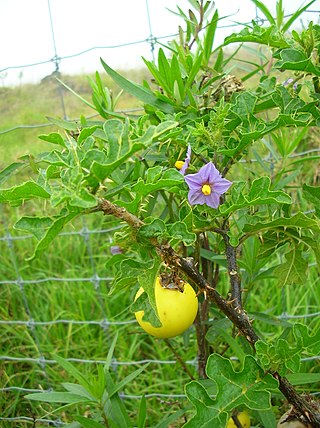
Eggplant, aubergine or brinjal is a plant species in the nightshade family Solanaceae. Solanum melongena is grown worldwide for its edible fruit.

Solanum is a large and diverse genus of flowering plants, which include three food crops of high economic importance: the potato, the tomato and the eggplant. It is the largest genus in the nightshade family Solanaceae, comprising around 1,500 species. It also contains the so-called horse nettles, as well as numerous plants cultivated for their ornamental flowers and fruit.

Solanum viarum, the tropical soda apple, is a perennial shrub native to Brazil and Argentina with a prickly stem and prickly leaves. The fruit is golf-ball-sized with the coloration of a watermelon. It is considered an invasive species in the lower eastern coastal states of the United States and recently on the Mid North Coast of Australia.

Solanum quitoense, known as naranjilla in Ecuador, Costa Rica, and Panama and as lulo in Colombia, is a tropical perennial plant from northwestern South America. The specific name for this species of nightshade means "from Quito."

Solanum aethiopicum, the bitter tomato, Ethiopian eggplant, or nakati, is a fruiting plant of the genus Solanum mainly found in Asia and Tropical Africa. It is also known as Ethiopian nightshade, garden eggs, pumpkin-on-a-stick, and mock tomato. It is a popular vegetable in north-east India, and is known as khamen akhaba in Manipuri and samṭawk in Mizo. They are called Titay bii or simply bii in Darjeeling, Sikkim and Nepal and are relished with meat, particularly pork. These names are a result of its varied morphology, with ripe fruit often looking like a cross between an eggplant and a tomato, which are also from Solanum. In fact, the Ethiopian eggplant was so much confused with the ordinary eggplant that this was considered by some a variety violaceum of S. aethiopicum.

Solanum mammosum, commonly known as nipplefruit, fox head, cow's udder, or apple of Sodom, is an inedible Pan-American tropical fruit. The plant is grown for ornamental purposes, in part because of the distal end of the fruit's resemblance to a human breast, while the proximal end looks like a cow's udder. It is an annual in the family Solanaceae, and part of the genus Solanum, making the plant a relative of the eggplant, tomato, and potato. This poisonous fruit is native to South America, but has been naturalized in Southern Mexico, Greater Antilles, Central America, and the Caribbean. The plant adapts well to most soils, but thrives in moist, loamy soil.

Solanum sessiliflorum, the cocona, is a tropical shrub of the family Solanaceae. The cocona plant has sturdy branches and huge, serrate and hairy leaves. Cocona closely resembles a number of close relatives, including naranjilla and pseudolulo. It can be distinguished from those plants by its lack of spines. It will hybridize with those and other close relatives. Cocona also lacks the characteristic purple coloring usually seen in the naranjilla. Its flowers resemble large potato flowers, with light green petals. Cocona is harvested in parts of South America around the Amazon rainforest such as Purús Province in eastern Peru.

In botany, a berry is a fleshy fruit without a stone (pit) produced from a single flower containing one ovary. Berries so defined include grapes, currants, and tomatoes, as well as cucumbers, eggplants (aubergines) and bananas, but exclude certain fruits that meet the culinary definition of berries, such as strawberries and raspberries. The berry is the most common type of fleshy fruit in which the entire outer layer of the ovary wall ripens into a potentially edible "pericarp". Berries may be formed from one or more carpels from the same flower. The seeds are usually embedded in the fleshy interior of the ovary, but there are some non-fleshy exceptions, such as Capsicum species, with air rather than pulp around their seeds.

Solanum muricatum is a species of evergreen shrub native to South America and grown for its sweet edible fruit.

Solanum torvum, the turkey berry, devil's fig, pea eggplant, platebrush or susumber, is a bushy, erect and spiny perennial plant used horticulturally as a rootstock for eggplant. Grafted plants are very vigorous and tolerate diseases affecting the root system, thus allowing the crop to continue for a second year.

Solanum linnaeanum is a nightshade species known as devil's apple and, in some places where it is introduced, apple of Sodom. The latter name is also used for other nightshades and entirely different plants elsewhere, in particular the poisonous milkweed Calotropis procera.
Solanum cajanumense is a species of plant in the family Solanaceae. It is found in Colombia, Ecuador, and Peru.

Solanum caripense is a species of evergreen shrub native to South America and grown for its edible fruit.
Solanum candidum is a species of evergreen shrub native to South America and occasionally grown for its edible fruit.
Solanum repandum is a species of evergreen shrub native to various island groups across the southern Pacific Ocean and occasionally grown for its edible fruit.
Solanum vestissimum is a subtropical perennial plant from northwestern South America. Also known within its native range as toronjo, tumo, or coquina melón, S. vestissimum is a large semi-woody plant or shrub, up to 8 meters in height, though usually much smaller. The very large heart-shaped leaves are lined with spines along the top and bottom of the dorsal vein, similar to the naranjilla or pseudolulo. The leaves and stems of the plant are otherwise covered in short, felt-like hairs.

Solanum macrocarpon otherwise known as the African eggplant : añara), Surinamese eggplant or Vietnamese eggplant is a plant of the family Solanaceae. S. macrocarpon is a tropical perennial plant that is closely related to the eggplant. S. macrocarpon originated from West Africa, but is now widely distributed in Central and East Africa. The plant also grows in the Caribbean, South America, and some parts of Southeast Asia. S. macrocarpon is widely cultivated for its use as a food, its medicinal purposes, and as an ornamental plant.

Solanum virginianum, also called Surattense nightshade, yellow-fruit nightshade, yellow-berried nightshade, Indian nightshade,Thai green eggplant, or Thai striped eggplant, is a medicinal plant used mostly in India. Some parts of the plant, like the fruit, are poisonous. The common name is Kantakari. Solanum surattense Burm. f. and Solanum xanthocarpum Schrad. and Wendl. are synonyms of Solanum virginianum L..

The Solanaceae, or the nightshades, are a family of flowering plants that ranges from annual and perennial herbs to vines, lianas, epiphytes, shrubs, and trees, and includes a number of agricultural crops, medicinal plants, spices, weeds, and ornamentals. Many members of the family contain potent alkaloids, and some are highly toxic, but many—including tomatoes, potatoes, eggplant, bell and chili peppers—are used as food. The family belongs to the order Solanales, in the asterid group and class Magnoliopsida (dicotyledons). The Solanaceae consists of about 98 genera and some 2,700 species, with a great diversity of habitats, morphology and ecology.
Solanum cerasiferum is a species of plant in the nightshade family. It is native to tropical Africa.















